

- #Stickies for windows file location windows xp how to#
- #Stickies for windows file location windows xp install#
- #Stickies for windows file location windows xp archive#
- #Stickies for windows file location windows xp professional#
#Stickies for windows file location windows xp professional#
This is the default sample content of the Boot.ini file in a Windows Xp Professional computer:ĭefault = multi (0) disk (0) rdisk (0) partition (1) WINDOWS Follow the steps 1-3 above to reopen the Boot.ini file. Double-click the newly created folder, then click the Save button to save a copy of the Boot.ini file to the new folder.Ĭlose the recently opened Notepad file window.
#Stickies for windows file location windows xp archive#
Enter a name for the new folder (for example Luu ) and press Enter to create a new archive folder for the Boot.ini fileħ. Right-click an empty area of the Save As dialog box, select New -> FolderĦ. In Notepad, click File on the menu bar and select Save Asĥ. The Notepad program will open the system Boot.ini file for editing.Ĥ. On the Advanced tab, select Settings under Startup and Recovery. Ĭlick Start, click Run, type sysdm.cpl and then click OKĢ. Right-click My Computer then select Properties. Click Yes to confirm that you want to display the entire file system, and then click OK. In the Advanced Settings section, click Show hidden files and folders, remove the Hide extensions for known files types and Hide protected operating system files (Recommended). In the Folder Options dialog box, select the View tabĥ. The first task to do is to remove the option to hide the file system and then back up the Boot.ini file.ġ. In Windows XP, you can quickly and easily find the location of the Boot.ini file so you can check or edit this file system.īefore having any modifications to the file system you should back up the file, in which case you need to backup the Boot.ini file before editing.
#Stickies for windows file location windows xp how to#
This article will tell you how to view and configure manually the Windows XP Boot.ini file from within the Startup and Recovery dialog box. I copied the folder and contents to a cd and deleted the folder with no ill effects.Windows XP has just been updated but after restarting, the error message " Invalid Boot.ini " or " Windows could not start because the following file is missing or corrupt: WindowsSystem32Hall.dll ", what will you do? Do you want to re-select the first boot-up operating system in your "multi-operating system" system? All of these actions require a small impact on the Windows XP Boot.ini file system, which is completely manageable. If your talking about the folder that has a long number with two sub folders in it amd64 and i386 from what I have read it is a glitchįrom updating to the latest net frame work and the files contained in that folder are what was extracted during the update. Under each folder or file there are sub files, so if you wanted to go to say your host file that path would or at least should be Your Operating files would be listed as C:\Windows\ Followed by the file or folder of a particular system file.
#Stickies for windows file location windows xp install#
In a default install C: is your root directory and the hierarchy of your installed files and sub folders are listed under that directory I would say it is unlikely that "extra" files in the root directory are contributing to your slowness issue, but there is a "Slow Computer" sticky post at the top of this forum to help you get started and help you ask the right questions regarding that issue. If you are not sure about a file or folder and can't find anything in a Google search, this is a good place to ask about specific examples. Here is one of many articles (this one from 2003) that helps understand what you can expect to see in the system partition (C:\) and some of the folders that XP creates and mantains. I am happy with the contents of my C:\ because I look at it once in a while and clean up things that I cannot explain what they are and what they do. I do not have a C:\SYSTEM folder, but I do have a C:\WINDOWS\SYSTEM and C:\WINDOWS\SYSTEM32 folder. Most of the required files are going to be hidden and sometimes read only so you don't accidentally hurt yourself. Sometimes, files end of there through actions of the user or an installation - log files for example. In a typical installation of XP installed on the C drive, some files are required to be in the C:\ and if they are missing XP will complain and/or you would not be posting from the computer.


 0 kommentar(er)
0 kommentar(er)
